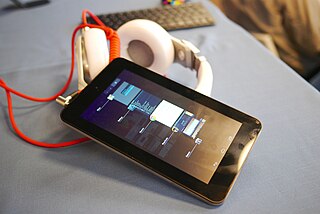
Itanium is a discontinued family of 64-bit Intel microprocessors that implement the Intel Itanium architecture. The Itanium architecture originated at Hewlett-Packard (HP), and was later jointly developed by HP and Intel. Launched in June 2001, Intel initially marketed the processors for enterprise servers and high-performance computing systems. In the concept phase, engineers said "we could run circles around PowerPC...we could kill the x86." Early predictions were that IA-64 would expand to the lower-end servers, supplanting Xeon, and eventually penetrate into the personal computers, eventually to supplant reduced instruction set computing (RISC) and complex instruction set computing (CISC) architectures for all general-purpose applications.

The Buryats are a Mongolic ethnic group native to southeastern Siberia who speak the Buryat language. They are one of the two largest indigenous groups in Siberia, the other being the Yakuts. The majority of the Buryats today live in their titular homeland, the Republic of Buryatia, a federal subject of Russia which sprawls along the southern coast and partially straddles Lake Baikal. Smaller groups of Buryats also inhabit Ust-Orda Buryat Okrug and the Agin-Buryat Okrug which are to the west and east of Buryatia respectively as well as northeastern Mongolia and Inner Mongolia, China. They traditionally formed the major northern subgroup of the Mongols.

IEEE 488, also known as HP-IB and generically as GPIB, is a short-range digital communications 8-bit parallel multi-master interface bus specification developed by Hewlett-Packard. It subsequently became the subject of several standards.

The Chevrolet Corvette is a line of American two-door, two-seater sports cars manufactured and marketed by General Motors under the Chevrolet marque since 1953.

The Miniature Card or MiniCard is a flash or SRAM memory card standard first promoted by Intel in 1995. The card was backed by Advanced Micro Devices, Fujitsu and Sharp Electronics. They are no longer manufactured. The Miniature Card Implementers Forum (MCIF) promoted this standard for consumer electronics, such as PDAs and palmtops, digital audio recorders, digital cameras and early smartphones. The Miniature Card is 37 × 45 × 3.5 mm thick and can have devices on both sides of the substrate. Its 60-pin connector was a memory-only subset of PCMCIA and featured 16-bit data and 24-bit address bus with 3.3 or 5-volt signaling. Miniature Cards support Attribute Information Structure (AIS) in the I²C identification EEPROM.

The VQ is a family of V6 automobile petrol engines developed by Nissan and produced in displacements varying from 2.0 L to 4.0 L. Designed to replace the VG series, the all-aluminium 4-valve per cylinder DOHC design debuted with Nissan's EGI/ECCS sequential multi-point fuel injection (MPFI) system. Changes from the VG engine include switching to a timing chain from a timing belt, and relocating the water pump from the outside of the engine to inside the timing cover where the pump is driven by the timing chain. Later versions featured various improvements, such as variable valve timing, and NEO-Di designated VQ engines replace MPFI with direct fuel injection.

The VG engine is a family of V6 engines designed and produced by Nissan between 1983 and 2004.

The F20C and F22C1 were inline-4 engines produced by Honda for use in the Honda S2000. They are one of the few Honda 4-cylinder automobile engines that are designed to sit longitudinally for rear wheel drive.

The J-series is Honda's fourth production V6 engine family introduced in 1996, after the C-series, which consisted of three dissimilar versions. The J-series engine was designed in the United States by Honda engineers. It is built at Honda's Anna, Ohio, and Lincoln, Alabama, engine plants.

The Chrysler Hemi engine, known by the trademark Hemi or HEMI, refers to a series of high-performance American overhead valve V8 engines built by Chrysler with hemispherical combustion chambers. Three generations have been produced: the FirePower series from 1951 to 1958; a famed 426 cu in (7.0 L) race and street engine from 1964-1971; and family of advanced Hemis (displacing between 5.7 L 6.4 L from 2003 to 2024.
SRT is an American badge of high-performance vehicles manufactured by Stellantis, mainly ones of the Dodge brand.

The R607 is a model of digital camera produced by Hewlett-Packard, under the Photosmart line of cameras and photo printers.
Edgeline printing is a printing technology based on ink jet printing. In the case of traditional ink jet printers, the tiny matchbox size print head moves back and forth. This has inherent delay and requires two dimensional movement: (a) movement of print head; and (b) movement of paper. These movements are one of the reasons for the time lag in the ink jet printing.

The Hewlett-Packard Company, commonly shortened to Hewlett-Packard or HP, was an American multinational information technology company headquartered in Palo Alto, California. HP developed and provided a wide variety of hardware components, as well as software and related services to consumers, small and medium-sized businesses (SMBs), and fairly large companies, including customers in government, health, and education sectors. The company was founded in a one-car garage in Palo Alto by Bill Hewlett and David Packard in 1939, and initially produced a line of electronic test and measurement equipment. The HP Garage at 367 Addison Avenue is now designated an official California Historical Landmark, and is marked with a plaque calling it the "Birthplace of 'Silicon Valley'".

The Barga are a subgroup of the Buryats which gave its name to the Baikal region – "Bargujin-Tukum" – "the land's end", according to the 13th-14th centuries Mongol people's conception.

AirPrint is a feature in Apple Inc.'s macOS and iOS operating systems for printing without installing printer-specific drivers.

The HP Slate 7 is a 7-inch Android 4.1 tablet that was announced on February 24, 2013, and started shipping in April 2013. It has a stainless-steel frame, black front, and gray or red soft-touch back. A key feature of this small tablet is the microSDHC slot. It is HP's second Android device.

DigitaOS was a short lived digital camera operating system created by Flashpoint Technology and used on various Kodak, Pentax, and HP cameras in the late 1990s.

















